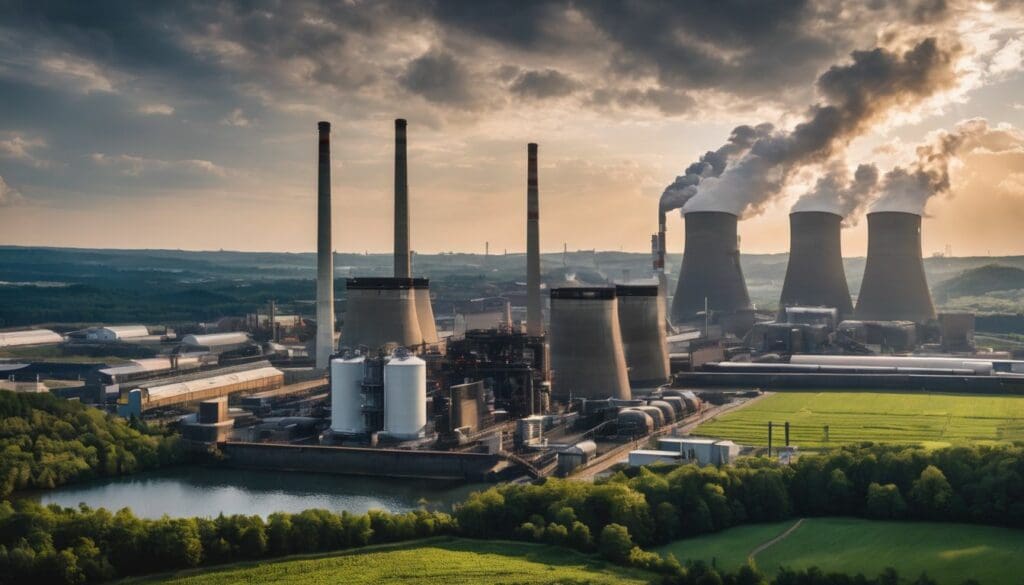As our world turns to cleaner energy, many worry about coal’s place in our future. Once a cornerstone of electricity generation, coal is now being outpaced by renewable sources. This article explores what that means for power supply, jobs, and the environment.
Keep reading to see coal’s new role!
Key Takeaways
- Coal consumption is falling as people choose renewable energy for a cleaner environment, leading to less use of coal in generating electricity.
- New jobs in sustainable industries like wind and solar power are opening up as coal declines, offering alternative careers for displaced workers.
- Governments are helping coal workers move to new jobs through retraining programs and financial support while also backing the growth of renewable energy sources.
- To keep electricity reliable with more renewables being used, we need smart grids, better storage for energy, and ways to manage power supply changes.
- For a successful switch from coal to cleaner energies, everyone must work together: governments, businesses, communities, and the public must all support this change.
Coal’s Decline in the United States
In the United States, coal consumption has been on the decline in recent years, with a significant increase in the use of renewable energy sources. This shift reflects a growing awareness of the environmental impact of coal production and a desire for cleaner, more sustainable energy alternatives.
Decreased coal consumption
Coal consumption is on a steady decline across the globe, reflecting an energy sector in transition. As clean energy alternatives become more cost-competitive and efficient, they chip away at coal’s dominance in the electricity system.
This shift signals a significant change for countries once reliant on coal production, pointing towards a carbon-constrained world that prioritises lower carbon emissions.
Governments and industries are increasingly investing in renewable energy sources, recognising their long-term benefits over fossil fuels. The move away from coal not only helps combat climate change but also reshapes the landscape of energy production.
Renewables offer an array of advantages, including sustainability and reduced environmental impact—traits highly valued by conservationists and those keen on protecting our planet’s future.
Increase in renewable energy sources
As coal consumption decreases, renewable energy sources are on the rise. Wind and solar power have become more prevalent, offering clean and sustainable alternatives to traditional coal-generated electricity.
The demand for greener energy solutions has led to significant advancements in technology, making renewables more efficient and cost-effective. As a result, the shift towards renewable energy sources is not only reducing carbon emissions but also creating new opportunities for economic growth and job creation within the energy sector.
The transition to increased use of renewable energy sources presents a promising outlook for a cleaner and more sustainable future. Embracing these alternative sources of power is crucial in addressing environmental concerns while also driving innovation and progress in the energy industry.
Impact on Grid Reliability
Maintaining grid reliability in the face of decreasing coal consumption and increasing renewable energy sources presents challenges that require innovative solutions for integration.
Challenges in maintaining reliability
Coal’s decline has led to challenges in maintaining reliability in the energy sector. These challenges include the intermittent nature of renewable energy sources and the need for backup power. To overcome these challenges, various solutions are being implemented:
- Integrating energy storage systems to store excess renewable energy and ensure consistent power supply.
- Implementing advanced grid technologies to manage fluctuations in power generation from renewables.
- Developing smart grid systems that can efficiently balance supply and demand while integrating diverse energy sources.
- Diversifying the energy mix by combining renewables with natural gas and other low – emission sources.
- Investing in research and development of new technologies for efficient and reliable renewable energy integration.
Solutions for integrating renewables
As we look to address challenges in maintaining energy grid reliability, it’s vital to consider solutions for integrating renewables into the energy sector. This is crucial for a sustainable and carbon-constrained world. Here are some ways to achieve this:
- Implementing smart grid technologies to efficiently manage the integration of intermittent renewable energy sources.
- Expanding energy storage capabilities to store excess renewable energy for use during low generation periods.
- Enhancing interconnection infrastructure to facilitate the seamless transmission of renewable energy across different regions.
- Developing innovative tariff structures that incentivise the adoption of renewable energy by consumers and businesses.
- Encouraging research and investment in clean coal technology as a transitional source of reliable power while increasing the share of renewables.
- Collaborating with policymakers, industry leaders, and community stakeholders to create supportive policies and public awareness campaigns promoting renewable energy adoption.
Addressing Job Displacements
The decline of coal in the energy sector has led to job displacements for many workers in the industry. This section will discuss alternative job opportunities and government support for those affected by this shift.
Alternative job opportunities
As the coal industry undergoes a transition, there are alternative job opportunities available for workers. Moving towards a carbon-constrained world requires skilled workers in various sectors, and the energy industry offers diverse roles suitable for transitioning workers. Here are some alternative job opportunities to consider:
- Renewable energy sector: Jobs in solar, wind, and hydro power industries offer stable employment opportunities with the growing demand for clean energy technologies.
- Energy efficiency and conservation: Positions in energy auditing, building retrofitting, and sustainable construction contribute to reducing carbon emissions while creating new job prospects.
- Environmental restoration: Roles focused on land reclamation and ecological rehabilitation following mining operations provide meaningful work that supports environmental conservation efforts.
- Clean technology development: Innovations in clean energy solutions require skilled workers for research, development, and implementation of new technologies to drive the energy transition forward.
- Green infrastructure projects: Careers in designing and constructing sustainable infrastructure, such as smart grids and sustainable transportation systems, contribute to advancing environmental sustainability goals.
Government support for coal workers
The government provides retraining programs and financial assistance to help transitioning coal workers find new job opportunities. These initiatives aim to support workers in acquiring the skills needed for employment in growing industries such as renewable energy, construction, and manufacturing.
Additionally, policies are being developed to promote economic diversification in regions heavily reliant on coal mining, fostering alternative sources of income and creating a more sustainable future for affected communities.
By prioritising the well-being of coal workers through targeted support and investment in regional development, the government plays a crucial role in mitigating the social and economic impact of coal phase-out.
Overcoming Non-Technical Barriers
Addressing the political and social challenges that come with transitioning away from coal, as well as the importance of gaining public support for alternative energy sources.
Political and social challenges
Coal faces significant political and social challenges due to increasing environmental awareness. Public opinion and policies are shifting towards renewable energy sources, creating resistance against coal.
Communities relying on coal mining face economic instability, while policy changes can have a direct impact on jobs. Overcoming these challenges requires collaborative efforts between policymakers, industry leaders, and the public to create a smooth transition towards sustainable energy solutions.
Government policies play a crucial role in supporting the shift from coal to renewables. Public engagement and education are essential for promoting understanding of the long-term benefits of transitioning away from coal.
Importance of public support
Transitioning from the political and social challenges, it is evident that public support plays a crucial role in shaping the future of coal in the energy sector. The backing of environmentally conscious individuals can influence policies towards sustainable practices and renewable energy sources.
It is essential for the public to advocate for conservation measures and environmental protection to drive change in energy policy.
The engagement of communities can further highlight the importance of transitioning towards cleaner energy alternatives, creating a more carbon-constrained world. Public support empowers decision-makers to consider renewable options, ultimately influencing the short-term energy outlook and addressing both advantages and disadvantages within the industry.
Conclusion
In conclusion, the future of coal in the energy sector is uncertain. Shifting towards renewable energy sources is essential for a sustainable future. Finding alternative job opportunities and addressing non-technical barriers are crucial steps in this transition.
Public support plays a significant role in driving change towards a cleaner, greener energy landscape.
FAQs
1. What does the future look like for coal in the energy sector?
In a carbon-constrained world, the future of coal in the energy sector faces challenges as demand shifts towards cleaner energy sources.
2. How does coal compare to other forms of energy?
Coal has certain advantages such as being an abundant and reliable source of power; however, it has disadvantages including significant carbon emissions affecting its long-term viability in our energy mix.
3. Will there be any demand for coal in the short term?
According to short-term energy outlooks, while there may still be some demand for coal due to existing infrastructure and economical factors, this is expected to decline steadily over time.
4. Are steps being taken to reduce coal usage in the energy sector?
Yes, with increasing awareness of environmental impacts, measures are being implemented globally to lower reliance on coal and pivot towards more sustainable forms of energy.





